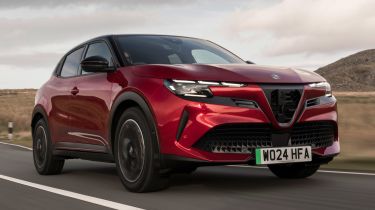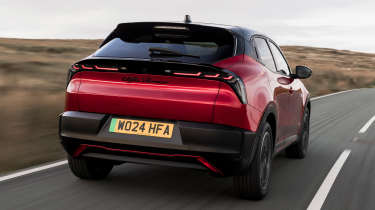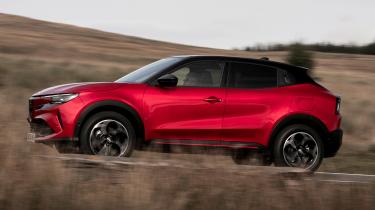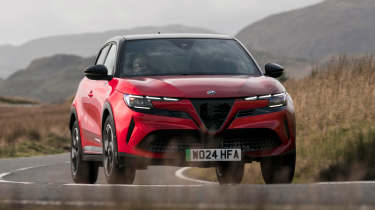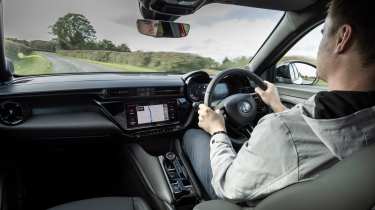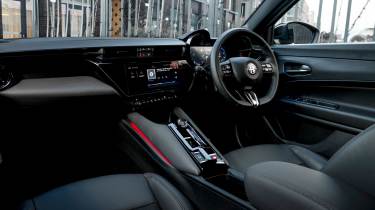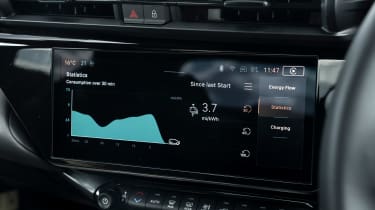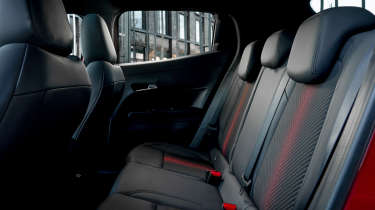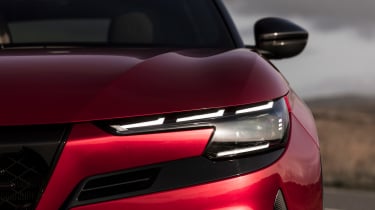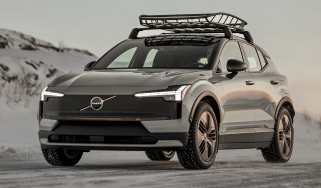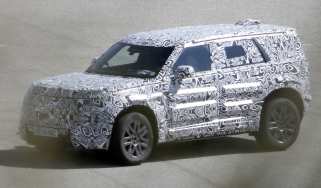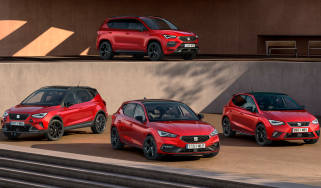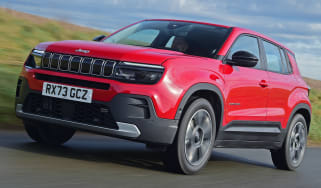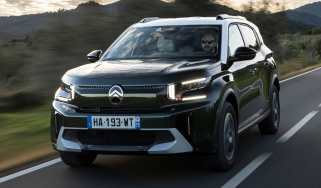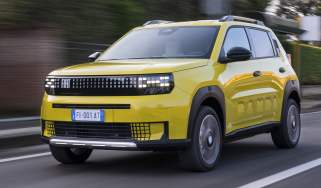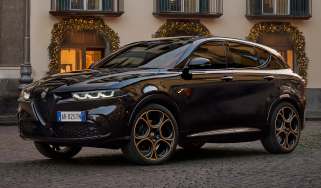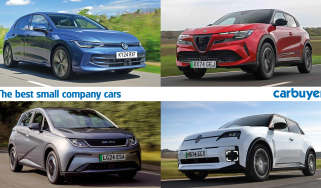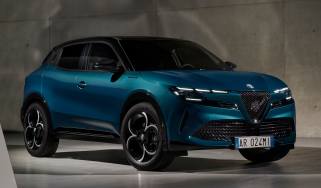Alfa Romeo Junior review – a great first EV for the Italian brand
“The Alfa Romeo Junior is great to drive and exudes an air of quality making it a brilliant first EV for the brand”
Pros
- Engaging to drive
- High-quality interior
- Unique design
Cons
- Short range
- Expensive
- Mediocre charge times
Verdict – is the Alfa Romeo Junior a good car?
The Alfa Romeo Junior represents a huge step for the Italian brand as its first electric model. In Veloce guise at least, it’s managed to inject a healthy dose of individuality into the model that helps it stand out from many of the small electric SUVs with which it shares a platform. It offers a more engaging drive, unique looks and a plusher interior, but the downside is that it’s quite expensive for what it is.
Alfa Romeo Junior models, specs and alternatives
The launch of the Alfa Romeo Junior got off to a shaky start – the brand’s small SUV was originally set to be called the Alfa Romeo Milano, before having to change its name a few days later following complaints from the Italian government about using one of its city’s names for the model when it’s actually built in Poland. It was then hastily dubbed the Junior in reference to its position as the smallest model in Alfa Romeo’s lineup, while also harking back to one of its iconic classic models.
The Alfa Romeo Junior is based on the same basic underpinnings as cars like the Peugeot E-2008, Jeep Avenger, Citroen e-C4 and Vauxhall Mokka, but Alfa Romeo has tweaked more of the gubbins underneath to make it feel like an Alfa from behind the wheel, so it’s a bigger departure away from those cars.
For starters, the Junior gets an arguably more striking design that stands out with Alfa’s ‘Scudetto’ grille up front with the logo reimagined to cover the entirety of it. There are also sleek thin headlights and at the rear the tail-lights span the entire width of the car in a handle-bar-like shape.
For now, the Elettrica Veloce gets a modest 54kWh battery, which means it’s capable of up to 208 miles of range – that’s not particularly far, but a second electric model, known simply as Junior Elettrica, will later be introduced with a longer range that will come at the expense of some of the Junior’s power, as well as a mid-range Elettrica Speciale model.
While the Junior Elettrica is electric, Alfa also sells the Junior as a petrol mild hybrid, badged Ibrida. This is around £6,000 cheaper than the EV and uses the same engine and hybrid system as its Peugeot, Jeep, Citroen and Vauxhall sister cars.
We tested the Alfa Romeo Junior in a head-to-head battle against the MINI Aceman in which the Junior just about came out on top. This was mostly down to the fact that the MINI Aceman – while sharp and nimble to drive – offered a much harsher ride. The Junior gets the balance just right in terms of driving feel and comfort, which was what ultimately won us over.
| Trim levels | Power options |
|
|
MPG, running costs & CO2 emissions
The Alfa Romeo Junior is the first fully electric car released by the Italian manufacturer, but the mild-hybrid Ibrida version is the more affordable way into ownership in terms of list price, costing around £6,000 less than the EV.
This model gets a 1.2-litre petrol engine and a small electric motor that can take over when manoeuvring at low speeds. The motor helps to boost efficiency, and Alfa claims the Junior Ibrida will return up to 54.3mpg on the WLTP test cycle.
From launch, the top Alfa Romeo Junior Elettrica Veloce gets a 54kWh battery with a fairly modest range. Still, the range of just over 200 miles should be enough for most drivers that do shorter trips around town and B-road blasts, and if you do need to top up, a charge from 20-80% will take around 30 minutes at the maximum 100kW charge speed, which is on par with most rivals. A MINI Aceman’s maximum charging speed is 95kWh, though this difference might feel negligible in practice.
The cheaper Junior Elettrica model is capable of up to 255 miles to a charge (WLTP), or 371 miles if you stick to the city, which will make it the best option for those after distance rather than speed. This compares to 250 and 248 miles for the Peugeot E-2008 and Jeep Avenger, while the entry-level Hyundai Kona manages up to 234 miles.
An 11kW on-board charger is standard, which can replenish the car from zero to 100% in less than six hours. At the time of writing, Alfa Romeo will also throw in a free home EV wallbox worth around £1,000.
| Model | Battery size | Range |
| Alfa Romeo Junior Elettrica | 54kWh | 255 miles |
| Alfa Romeo Junior Elettrica Speciale | 54kWh | 215 miles |
| Alfa Romeo Junior Elettrica Veloce | 54kWh | 208 miles |
How much will the Alfa Romeo Junior cost in tax?
Electric versions of the Alfa Romeo Junior will be the cheapest to tax. Their zero-emissions status means they’re currently exempt from VED (road tax) until 2025, from which point the system will change and it will cost £10 for the first year, and then the standard rate thereafter. Mild-hybrid versions of the Junior will cost the standard rate of VED.
What will the Alfa Romeo Junior cost to insure?
Insurance groupings for the Alfa Romeo Junior start from group 23 out of 50 for the 154bhp electric Elettrica, rising to group 34 for the Elettrica Veloce. We’d expect the mild-hybrid model to be the cheapest to insure when it arrives.
Engines, drive & performance
While the Alfa Romeo Junior is based on the same platform as other Stellantis products such as the Peugeot E-2008, Vauxhall Mokka and Jeep Avenger among others, one of the ways it stands out is the way it drives.
We’ve tested the hot Alfa Romeo Junior Elettrica Veloce – the first of the model lineup to go on sale, and the standard version. The Elettrica Veloce gets a single motor and front-wheel drive, but the motor itself is more powerful than what you’ll find in any of the aforementioned related models, with the Alfa getting 277bhp.
While it’s a punchy figure, it’s by no means groundbreaking, but what does work in the Junior’s favour is its low weight for an EV. At 1,590kg it’s lighter than most other EVs of this size and that’s great news for the driving experience.
The Elettrica Veloce also gets a mechanical Torsen limited-slip differential, of the first used on Alfa’s petrol hot hatches, but now fitted to its front-wheel drive EV. In a nutshell, a limited-slip differential is something the wheels are connected to that helps prevent one wheel from spinning power away (usually when powering out of a corner or junction), but the benefit to this mechanical variant is that it’s lighter and simpler than an electric system.
The rear suspension has also been simplified compared to that of the Alfa’s sister cars to save space, and we’re happy to report that it’s not negatively affected the Junior’s driving characteristics at all – in fact, we like the old-fashioned feel to it, and think that sometimes keeping things traditional can be effective. Alfa has struck a good balance between comfort and dynamic ability. In fact, we tested it head-to-head against the MINI Aceman and found it much more balanced than that car – while the Aceman feels agile and nimble, it’s seriously let down by its harsh, hard ride, which is where the Junior pips it.
Put your foot down and the Elettrica Veloce feels responsive, and an artificial engine note of a flat-four combustion engine has been added to give a little more character to the drive, which we liked. That response, plus steering that’s light and accurate makes it a great car for tackling a twisty road.
There’s a variety of drive modes to choose from: Dynamica, Natural and Advanced. The car definitely feels more engaging in Dynamica mode, while Natural gives a more easy-to-live-with character.
While it might not be quite as exciting, even the standard Alfa Romeo Junior feels pretty good to drive. You don't need to turn the small steering wheel far to tuck the Junior into a corner, and its suspension resists body lean well. Thankfully, despite it being a bit more sporty than its Stellantis siblings, the ride isn't completely ruined and it still soaks up the majority of bumps.
Petrol models
A mild-hybrid petrol model will soon be available to order in the UK, although we’re yet to test it. It gets the same engine and electric motor setup that’s used across the Stellantis lineup, in everything from the Vauxhall Frontera to the Peugeot 2008.
| Model | Power | 0-62mph | Top speed |
| Alfa Romeo Junior Ibrida 1.2-litre petrol mild hybrid | 134bhp | TBC | TBC |
Electric models
From launch the Alfa Romeo Junior was offered in the sportiest Elettrica Veloce guise, but it’s since been joined by the regular Elettrica. This less powerful model is aimed at buyers who’d rather have a longer range at the expense of some of the power, but it still feels responsive, even at higher speeds. It uses the same tried-and-tested motor used in many of Stellantis Group’s other cars, such as the Vauxhall Corsa and Jeep Avenger.
A mid-range version called the Elettrica Speciale gets 237bhp with a range sitting somewhere in between the other two models.
| Model | Power | 0-62mph | Top speed |
| Alfa Romeo Junior Elettrica | 155bhp | 9 seconds | TBC |
| Alfa Romeo Junior Elettrica Speciale | 237bhp | Around 7 seconds | TBC |
| Alfa Romeo Junior Elettrica Veloce | 277bhp | 5.9 seconds | 124mph |
Interior & comfort
The Alfa Romeo Junior’s cabin is neatly laid out and feels pretty well-built, although there are a few more scratchy plastics than we'd like. One particular high point is the front seats, which are electrically adjustable and offer a great driving position. We like the nods to Alfa’s history by way of cloverleaf-shaped air vents and analogue touches around the cabin. You may spot a few carry-over parts from other Stellantis models, but we like the fact there are at least some useful physical controls, such as those in a row beneath the central touchscreen.
Trim levels kick off with the standard Junior Elettrica, fitted with 18-inch alloy wheels, LED lighting, auto wipers and rear parking sensors. Inside, it gets eight-colour ambient lighting, and twin 10.25-inch displays with Apple CarPlay/Android Auto. The Elettrica Speciale is considered a special launch edition which will get a mix of features from across the range including red paint, 18-inch alloy wheels, unique model-specific upholstery, a steering wheel trimmed in leather, eight-colour interior ambient lighting and keyless entry and start.
Veloce is the range-topper, with 20-inch alloy wheels, sports suspension and brakes, a bi-colour roof, tinted windows and a sports body kit. Interior upgrades include a six-way electronically-adjustable driver’s seat with massage function, a leather steering wheel and metallic sports pedals and kick plates.
Is the Alfa Romeo Junior’s infotainment and sat-nav system easy to use?
The Alfa Romeo Junior sports a large 10.25-inch infotainment screen through which most of the car’s functions are accessible. All the tech felt intuitive and easy to use, with everything where you’d expect it to be and responsive to our commands. Widgets can be dragged around the screen to create a more customised layout to the driver’s preference, but we did find the positioning of the screen to be slightly low on the dashboard.
There’s also a 10.25-inch display ahead of the driver for the instrument display, but Alfa has given this area its own unique look with a bespoke shape to the surround of it reminiscent of old analogue dials. It's pretty clear and easy to read, but doesn't have quite the same level of customisation as some rivals.
Key features | |
|
Elettrica
|
Speciale Elettrica (Elettrica plus…)
|
|
Veloce (Speciale Elettrica plus…)
| |
Boot space, practicality & dimensions
One of the things that surprised us about our time with the Alfa Romeo Junior was the decent rear space passengers enjoy, despite the car’s small proportions – surprisingly, it’s actually taller than its Peugeot E-2008 and Jeep Avenger siblings. It’s not the most spacious interior on the market, of course, but two full-grown adults can expect an average amount of legroom in the back of this baby SUV. Alfa Romeo has cleverly packaged the Junior so that interior space has been prioritised. Cabin storage is a bit disappointing, though, with only a small centre console storage area and shallow door bins.
| Size comparison | |||
| Model | Length | Width | Height |
| Alfa Romeo Junior | 4,173mm | 1,781mm | 1,505mm |
| Jeep Avenger | 4,084mm | 1,776mm | 1,528mm |
| Peugeot 2008 | 4,304mm | 1,770mm | 1,523mm |
| Vauxhall Mokka | 4,151mm | 1,791mm | 1,531mm |
Does the Alfa Romeo Junior have a big boot?
The Alfa Romeo Junior boasts more boot space than many rivals with a respectable 400 litres on offer, though it’s worth noting that a Peugeot 2008 has a little more, while the forthcoming Kia EV3 is more practical and boasts 460 litres. Still, most buyers should be happy with that figure which has also been balanced with a good amount of cabin space for rear occupants. Flip the 60:40 rear seats down, and space rises to 1,265 litres. There’s a small loading lip to lift items over, and the boot aperture isn’t huge, but it is at least a rectangular shape.
| Boot space comparison | |
| Model | Boot space |
| Alfa Romeo Junior | 400 litres |
| Jeep Avenger | 355 litres |
| Peugeot 2008 | 434 litres |
| Vauxhall Mokka | 350 litres |
Reliability & safety
Alfa Romeo performs surprisingly well in the Driver Power customer satisfaction surveys. In 2023 it came in a very respectable fifth place out of 32 manufacturers ahead of all other Stellantis brands, with Peugeot in ninth, Citroen in 11th, Vauxhall in 24th and Fiat in 31st. Alfa Romeo slipped to 13th place in 2024, but this still kept it well ahead of Vauxhall and Fiat.
While we’re quite confident that reliability isn’t so much of a problem compared with Alfa Romeos of old, 26.7% of Alfa Romeo owners reported an issue with their car in the first year, which is slightly higher than average.
How safe is the Alfa Romeo Junior?
The Alfa Romeo Junior is yet to be tested by Euro NCAP, but it’s built on the same underpinnings as many other cars from sister brands. That’s not particularly confidence-inspiring, however – the Jeep Avenger with which it shares a platform achieved just three stars when it was tested. The Peugeot 2008 – another close relative – got a more impressive four-star rating, but this was carried out in 2019 before more stringent testing came into force.
The Junior comes with lane-keeping assistance, speed limit recognition, emergency braking assistance and pedestrian detection among other safety features, so there’s at least a lot of tech to help avoid accidents.
Should you buy an Alfa Romeo Junior?
Unlike the other cars sharing the Alfa Romeo Junior’s platform, the Junior itself stands out with a little extra pizzazz and some bespoke touches that make it feel a little more unique and special. There’s an extra air of quality that you don’t get from cars like the Jeep Avenger or Vauxhall Mokka, and even from the outside the Junior is arguably more striking than many other derivative SUVs on the market.
The work Alfa has put into the Junior is noticeable in the way it drives. It’s more engaging than other electric cars in this class and we liked the fake flat-four engine note pumped into the cabin for extra excitement. It doesn't feel too over the top or obnoxious.
It’s not perfect, of course – we wish it had a larger battery and some extra range, but also understand that the extra weight would compromise the Junior’s driving feel, and many around-town drivers will be happy enough with the 208 miles of range on offer – if not, there’s still a longer range model with all of the style and quality in a more efficient package.
But it’s the Junior Ibrida that’s likely to be the most popular in the UK when it arrives. It’s the cheapest model for a start, and still gets the standout looks and nice cabin of the Elettrica. We’ll have to reserve full judgement until we’ve driven it for ourselves later in the year.
What is the best Alfa Romeo Junior for keen drivers?
The Alfa Romeo Junior Elettrica Veloce is the most driver-focused version of the small SUV. We found it to be surprisingly engaging and fun to drive. Its 277bhp is a strong figure, although in the age of the EV, it’s not outstandingly so – what really helps the Elettrica Veloce stand out is its low weight combined with that power, making it feel agile and playful in the corners.
Alfa Romeo Junior alternatives
The Alfa Romeo has a large number of rivals in this market, many of which are developed under the same Stellantis parent company and use similar underpinnings. It has a premium edge, though and a mild-hybrid version will arrive, too, so the Junior will be up against more conventional premium petrol and hybrid competitors, too.
